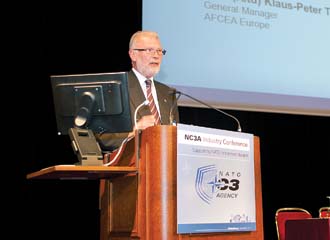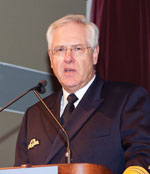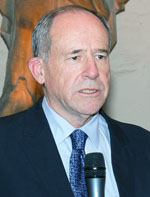Cyber, Budgets Challenge Transatlantic Planners
 |
Georges D’hollander, general manager of the NATO Consultation, Command and Control Agency, addresses the audience at TechNet International 2011 in Heidelberg, Germany. |
Cyberspace has become a new dimension in warfare and defense. And, just like the other dimensions—air, land and sea—it requires special operation tactics and technologies. Given the many advantages offered by cyberwarfare—low cost, widespread applicability and ease of operation—it is likely to be the weapon of choice for future aggressors menacing NATO and its allies.
These thoughts were among the main points aired at AFCEA TechNet International 2011, a conference organized by AFCEA Europe. With the theme “Supporting NATO in the Next Decade,” the conference hosted more than 700 attendees in the German town of Heidelberg on October 19-21 to discuss the future of cyber defense and how communication technologies have changed the militaries of the NATO countries.
For the first time, TechNet International was held in conjunction with the NATO Consultation, Command and Control Agency’s (NC3A’s) annual industry conference. Both events provided an opportunity for NATO and industry representatives, as well as for those from government and academia, to share ideas for supporting NATO’s transformation to meet today’s operational challenges.
Foremost among those challenges is the realm of cyberspace. “The ways of classical warfare cannot be applied to cyberwar,” pointed out Maj. Gen. Jaap Willemse, RNAF, assistant chief of staff, Command, Control, Communications, Computers and Intelligence (ACOS C4I), Allied Command Transformation. People need to take this into account when talking about cyber or communication technologies, but instead, most military and political leaders are still dealing with information technology as if it were just another minor technology that could be added easily to the existing system, he offered.
“The first priority is an international definition of the term cyberwar and what successful cyber defense—or even an adequate reply to a cyber attack—could look like,” said Gen. Willemse. “In classical engagements there has always been some code of conduct, but not in cyberspace.” The general underlined that no international law can be applied to cyberspace, no international agreements define rules and therefore no real proscription of actions exists. “As military, we need to define what our role in cyberspace is in order to take the right actions when NATO allies or our own countries are attacked,” he emphasized.
 |
(l to r) Lt. Gen. Walter E. Gaskin, USMC, deputy chairman, NATO Military Committee; Maj. Gen. Klaus-Peter Treche, GEAF (Ret.), AFCEA Europe general manager; and Maj. Gen. Jaap Willemse, RNAF, ACOS C4I, Allied Command Transformation, discuss cyberdefense. |
The main problem with cyber attacks is that they are not costly to undertake, Gen. Gaskin added. The hardware is inexpensive and can be purchased easily, although software needs some intelligent, skilled people. A cyber attack therefore is much less expensive than the classic types of warfare that consume a lot of money, starting with fuel for combat aircraft and ending with missiles used during attacks.
Another concern is that many information technology specialists from poor countries or failing states have studied in Europe, China, Russia or even the United States. The knowledge exchange about information technology security or cyber crime also is happening on a worldwide basis through the Internet, no matter where the person in need is situated. Accordingly, Gen. Gaskin named cyber technology as the future weapon that might be used by weak opponents against highly skilled armies.
“NATO nations and organizations already are frequently facing attacks,” the general said. “We need to develop further capabilities on cyber defense. And, we need to enhance the cooperation between the NATO nations in the field of cybersecurity.”
Gen. Gaskin pointed out that preparing for the future does not mean that experts can predict the future. “We did not predict the attacks of 9/11; neither did we predict the rise of the Arab Spring,” he said. “We are unlikely to predict the next major fundamental change in the security landscape.”
 |
Vice Adm. Wolfram Kühn, GE N, vice chief of staff of the Bundeswehr and the chief of staff of the Joint Support Service, addresses the issue of commercial technology in support of military operations. |
“The military is struggling to keep up with change in technology,” the admiral said. “Industry will always be on the ball—this is scope for more cooperation. In order to seize this opportunity, we need to change our approach to procurement. The military should focus on defining what we need, but not in terms of specific piece of equipment, but as a capability. Industry will then offer solutions—even providing solutions in theater.
“We do not want to procure a product, but a capability,” he elaborated. “Our main concern is reliability and completeness.”
Gen. Willemse addressed an ongoing technological challenge that is magnified in this era of budget constraints. “We need to spend less, but deliver more,” he declared. To do this, the alliance and its member nations need to prioritize and focus on critical capabilities, one of which was interoperability.
“All capabilities should be developed with an eye on interoperability,” the general continued. This point was emphasized forcefully by Gen. Gaskin during a dynamic question and answer session. “We do not want hardware; we want a capability and we want to do it multinationally, relevant timely and ready for use,” Gen. Gaskin stated.
As with any discussion of information technology capabilities, cloud computing surfaced. NC3A General Manager Georges D’hollander offered an appropriate analogy for the military’s concerns about moving information to the cloud.
“Cloud computing is like valet parking,” D’hollander said in a comment during a question and answer session. “It only works if you trust that the person can (a) drive and (b) won’t steal your car.”
High-level policy was the focus of a keynote by Robert Bell, the U.S. Secretary of Defense senior civilian representative in Europe and defense adviser, U.S. Mission to NATO. Speaking several hours after the historic capture of Libyan leader Moammar Ghadaffi, Bell said that the Libya campaign had exposed weaknesses in NATO’s armory. But, he stressed, in the end the alliance prevailed and succeeded in conducting a remarkable campaign, which included Swedish and Qatari fighter jets contributing to strike sorties.
 |
Robert Bell, the U.S. Secretary of Defense senior civilian representative in Europe and defense adviser, U.S. Mission to NATO, offers a high-level policy perspective. |
Major changes lie ahead for NATO’s organization, particularly the NC3A. As part of NATO’s agency reform, in July 2012 the NC3A will merge with other agencies to form the NATO Communications and Information Agency. The NC3A is responsible for the Alliance’s investment in advanced C4ISR capabilities, including cyber and missile defense and intelligence, surveillance and reconnaissance (ISR). During the conference, industry was updated on the time frame of the reform, including the potential impact on current NATO contract holders.
NC3A officials briefed more than 400 transatlantic industry representatives on upcoming contract opportunities worth approximately €1.5 billion ($2 billion). The projects outlined included upcoming procurements for satellite communications, cyber, missile defense and ISR assets that will be launched in 2012. Their strategic aim is to enable the alliance to counter modern security threats, further the transition strategy in Afghanistan, and undertake missions where and when necessary.
Cybersecurity and defense also were a main theme in the exhibition that accompanied the congress. More than 20 companies presented their solutions for a safer and more connected NATO during the three days of the international event. Because of the wide range of companies sharing their thoughts on emerging technologies and new opportunities for cooperation between the alliance, its member states and industry, the exhibition was an important addition to the speeches.




Comments